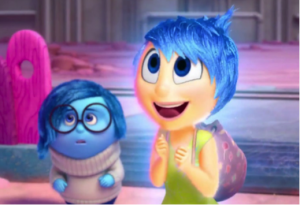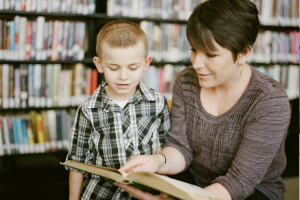What Inside Out Can Teach us about Loving our Kids
 The other day I recommended the movie Inside Out to my friend, Cynthia, as an intervention. Her favorite niece, Emily, is going through puberty. The sweet little girl who used to love shopping and doing craft projects with her aunt, is now moody and not interested in sharing those activities. Cynthia feels hurt about this change, but her efforts to control their relationship and get it “back on track” have backfired and made things even more strained between them. Now, sadly, Cynthia seems to have lost all affection and compassion for the girl she once adored. I hoped that by seeing the movie, she might soften and feel empathy for her niece. Inside Out may be a wild, animated romp for kids, but it packs at least three powerful messages for parents and caregivers.
The other day I recommended the movie Inside Out to my friend, Cynthia, as an intervention. Her favorite niece, Emily, is going through puberty. The sweet little girl who used to love shopping and doing craft projects with her aunt, is now moody and not interested in sharing those activities. Cynthia feels hurt about this change, but her efforts to control their relationship and get it “back on track” have backfired and made things even more strained between them. Now, sadly, Cynthia seems to have lost all affection and compassion for the girl she once adored. I hoped that by seeing the movie, she might soften and feel empathy for her niece. Inside Out may be a wild, animated romp for kids, but it packs at least three powerful messages for parents and caregivers.
The movie is about a 12 year old girl named Riley who is emotionally shaken up by her family’s relocation from Minnesota to San Francisco. This film is unique in that we get to know Riley from inside her body. The primary location of the film is her brain, and the lead characters are her emotions: Joy, Sadness, Fear, Disgust and Anger. As the story begins, Joy, played adorably by Amy Poehler, who has been doing a great job at the helm of Riley’s brain since infancy, struggles to keep Riley happy in the midst of big life changes. As Joy attempts to manage all of Riley’s perceptions and behavior, we observe a vast world of circuits, connections and memories that result in Riley’s personality. We watch a chain reaction of brain events that leaves Riley in a deep funk.
The first message we can glean from this film is: To some degree, our children are at the mercy of their brains! Of course, parents do influence their children tremendously through the “nurture” side of the equation, but learning about the “nature” of the brain, and all of the adaptive, inevitable developments that will occur in our children’s brains as they grow, can help us nurture our kids in the most sensitive and productive ways possible.
Riley’s parents are baffled by changes in her behavior, just as so many real parents feel helpless to intervene when our kids are acting in ways we don’t like or understand. Luckily, there are abundant resources that can teach us about the developing brain, so we can be more effective at loving our kids through all the stages of their lives. For example, what if my friend Cynthia learned that Emily’s brain is literally programmed to push away her family members at this age?
In the book Brainstorm: The Power and Purpose of the Teenage Brain, Dr. Daniel J. Siegel highlights what is important and valuable about teenage behavioral changes. Pushing away from their parents is the beginning of the process of leaving home for teens. Siegel says, “The courage to move out and away is created by the brain’s reward circuitry becoming increasingly activated and inspiring teens to seek novelty even in the face of the unfamiliar as they move out into the world” (2013). Siegel goes on to explain that, for our ancient ancestors, it was imperative that older adolescents left home and got away from their families to prevent inbreeding and genetic decline. In other words, the survival of the species dictates that children’s interests and personalities will change as they become adolescents.
Learning about the brain can be a lifesaver for the caregivers of younger kids too. How should I respond when my seven year old godson is having a tantrum? Apparently, that depends. In the book The Whole-Brain Child, authors Daniel J. Siegel and Tina Payne Bryson, explain that there are two different types of tantrums. An “upstairs tantrum” is a strategy that originates in the cerebral cortex. Siegel and Payne call it an “upstairs tantrum” because the child is using the higher brain functions of thought and planning to “essentially decide to throw a fit” in order to get what he wants (2012). During an upstairs tantrum, the child is in control of his feelings. If he were to get the object of his desire, he could immediately stop emoting. The authors’ suggestion for dealing with an upstairs tantrum: “Never negotiate with a terrorist.” A compassionate but firm response is appropriate to communicate that there will be no payoff for the manipulative behavior.
A “downstairs tantrum” involves a different part of the brain and requires a very different response. The lower part of the brain, from about the top of the neck to the bridge of the nose, is responsible for more basic survival functions, including powerful emotions like anger and fear, and fight or flight reactions (Siegel & Bryson, 2012). In a downstairs tantrum, the child’s higher brain function has gone “offline” and he cannot control his feelings. According to Siegel and Bryson, when trying to help a child who is having a downstairs tantrum, it is best to connect through touch or soothing voice and help him calm down. Later, when he has settled down and the cerebral cortex is back online, you can talk about what happened and help him make sense of it (2012).
These examples are just the tip of the iceberg when it comes to what experts know about kids’ developing brains, and it is well worth our while to learn as much we can.
Another powerful message in the film is: Sadness heals us. Just like Joy in the movie, my default approach is to try and stay positive. I avoid feeling sad if I possibly can. I don’t think I’m alone in this. I see my friends and family members struggle to stay “up”. But would our lives be richer and more satisfying if we did allow sadness to take the wheel more often?
In the movie, Riley can’t process all the changes in her life and be happy UNTIL she feels sadness. I laughed out loud many times while watching Inside Out, but what I loved most about the movie was that it made me feel sad, in the sweetest way. I cried, and when I walked out of the theatre I felt calmer and happier than when I walked in. Experts would say my improved mood was not a coincidence.
Within the large body of work by Dr. Robert Firestone, he has written extensively about the importance of feeling emotions. In the film, Coping with the Fear of Intimacy, he remarks on the irony of people’s fear of sadness, noting that, in his experience, they always feel better when they feel the sadness and get it out. As Firestone says, “Sadness tends to center people” (2000). Joseph Forgas of the Greater Good Science Center at UC Berkeley agrees that sadness has value in our lives. In his article titled “Four Ways Sadness May Be Good for You”, he refers to experiments that show mild episodes of sadness can “improve attention to external details, reduce judgmental bias, increase perseverance, and promote generosity” (2014). It should be noted that he also makes an important distinction between sadness and depression, which is a mood disorder that can be debilitating.
Looking back, I know that every time I have ever had “a good cry”, I felt freer and more connected to myself and other people afterward. I relate to what author Susan Piver says about sadness in a Mindful Magazine article called “The Importance of Sadness.” Piver writes, “Despair is what happens when you fight sadness. Compassion is what happens when you don’t. It will not feel ‘good.’ It will feel alive and this aliveness is the path to bliss” (2011).
The final message I received from thinking about the movie was this: It’s all about Integration. Joy and Sadness need to work together in order for Riley to thrive, and we need integration for optimum quality of life. Integration is the ideal state for our brains and for our feelings. When we help our kids to use their upstairs brains to make sense of what’s going on in their downstairs brains, we are helping them find integration. And when we allow our sad feelings to coexist with our happy feelings, we give ourselves the opportunity to be fully integrated and alive.
What does all this mean for my friend Cynthia? My guess is that she might feel better if she allowed herself to feel the sadness of watching Emily go from a child to an adolescent. By feeling her own sadness, as well as understanding that the changes in Emily’s brain are necessary and useful, Cynthia might get to a more accepting place. From there, she might find new ways to connect with Emily. Perhaps, instead of trying to force a shared activity, Cynthia could write a playful note that expresses her love and extends an open invitation to talk or hang out anytime Emily feels like it.
One thing is certain, by learning and feeling and integrating ourselves, we have more to offer the people in our lives. By being sensitive to ourselves, we can love other people better. It really is a no-brainer.
References
Forgas, J. P. (2014, June 4). Four Ways Sadness May Be Good for You. Retrieved July 28, 2015.
Glendon (Producer). (2001). Coping with the fear of intimacy [Motion picture on DVD]. United States.
Piver, S. (2011, April 20). The importance of sadness. Retrieved July 28, 2015.
Siegel, D. J. (2013). Brainstorm: The power and purpose of the teenage brain. New York, NY: Penguin Group.
Siegel, D. J., & Bryson, T. P. (2012). The whole-brain child: 12 revolutionary strategies to nurture your child’s developing mind. New York: Delacorte Press.
Tags: child development, child emotional health, children, children and emotions, emotion in kids, parent emotion, parenting, teenagers








Leave a Reply